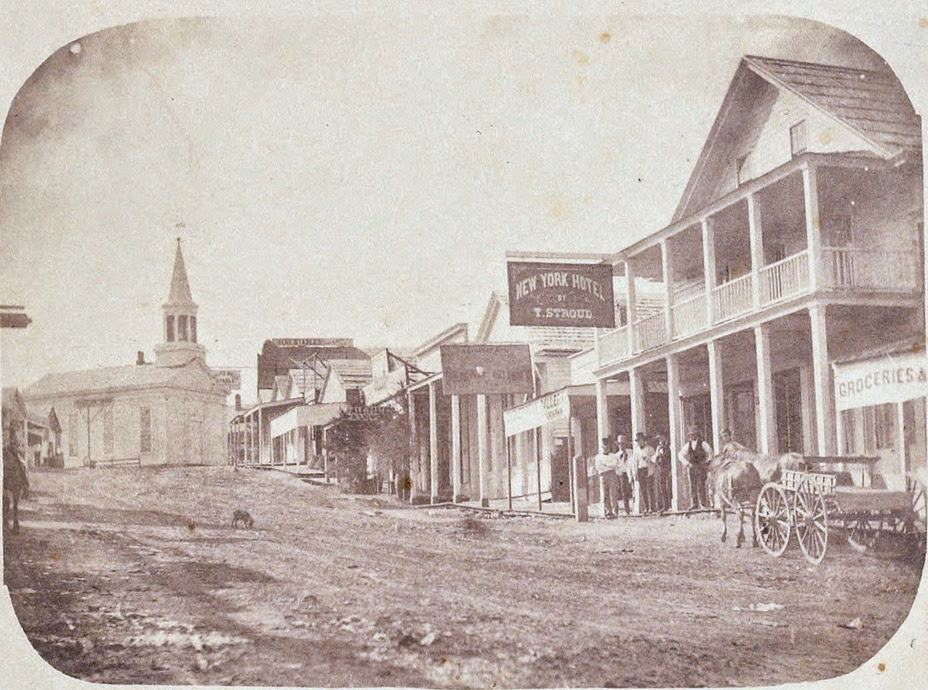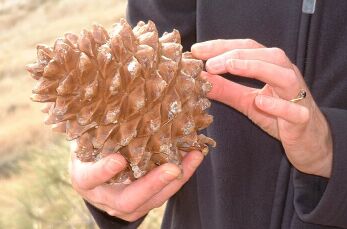|
Dubakella (Soil)
Dubakella soil series is the name given to a reddish-brown stony loam soil which has developed on ultramafic rock containing magnesium minerals such as serpentine or asbestos. This soil occurs from southwestern Oregon south to the Coast Ranges of California near Healdsburg, and it also is found in the Sierra Nevada mountains and foothills. In common with other ultramafic soils, Dubakella has a poor balance of nutrients which does not allow the vegetation it supports to match the luxuriance seen on adjacent non-ultramafic sites. Jeffrey Pine is usually the most common tree, accompanied by Douglas-Fir, Incense-Cedar, and Sugar Pine—all in open, somewhat stunted stands. Stunting may be less severe in areas which have been dusted with nutrient-bearing volcanic ash. In some areas, as at Grass Valley and near Nevada City, the less stately Gray Pine is dominant. On the poorest sites vegetation may be held to a chaparral-like state. In addition to being inferior for forestry and poor fo ... [...More Info...] [...Related Items...] OR: [Wikipedia] [Google] [Baidu] |
Ultramafic
Ultramafic rocks (also referred to as ultrabasic rocks, although the terms are not wholly equivalent) are igneous and meta-igneous rocks with a very low silica content (less than 45%), generally >18% MgO, high FeO, low potassium, and are composed of usually greater than 90% mafic minerals (dark colored, high magnesium and iron content). The Earth's mantle is composed of ultramafic rocks. Ultrabasic is a more inclusive term that includes igneous rocks with low silica content that may not be extremely enriched in Fe and Mg, such as carbonatites and ultrapotassic igneous rocks. Intrusive ultramafic rocks Intrusive ultramafic rocks are often found in large, layered ultramafic intrusions where differentiated rock types often occur in layers. Such cumulate rock types do not represent the chemistry of the magma from which they crystallized. The ultramafic intrusives include the dunites, peridotites and pyroxenites. Other rare varieties include troctolite which has a greater percenta ... [...More Info...] [...Related Items...] OR: [Wikipedia] [Google] [Baidu] |
Nevada City, California
Nevada City (originally, ''Ustumah'', a Nisenan village; later, Nevada, Deer Creek Dry Diggins, and Caldwell's Upper Store) is the county seat of Nevada County, California, United States, northeast of Sacramento, southwest of Reno and northeast of San Francisco. The population was 3,068 as of the 2010 Census. History European-Americans first settled Nevada City in 1849, during the California Gold Rush, as Nevada (Spanish for "snow-covered", a reference to the snow-topped mountains in the area). The ''Gold Tunnel'' on the north side of Deer Creek was the city's first mine, built in 1850. The first sawmill in Nevada City was built on Deer Creek, just above town, in August 1850, by Lewis & Son, with a water wheel. In 1850–51, Nevada City was the state's most important mining town, and Nevada County the state's leading gold-mining county. In 1851, '' The Nevada Journal'' became the first newspaper published in the town and county. The first cemetery in town, the Pioneer Cemeter ... [...More Info...] [...Related Items...] OR: [Wikipedia] [Google] [Baidu] |
Serpentine Soils
Serpentine soil is an uncommon soil type produced by weathered ultramafic rock such as peridotite and its metamorphic derivatives such as serpentinite. More precisely, serpentine soil contains minerals of the serpentine subgroup, especially antigorite, lizardite, and chrysotile or white asbestos, all of which are commonly found in ultramafic rocks. The term "serpentine" is commonly used to refer to both the soil type and the mineral group which forms its parent materials. Serpentine soils exhibit distinct chemical and physical properties and are generally regarded as poor soils for agriculture. The soil is often reddish, brown, or gray in color due to its high iron and low organic content. Geologically, areas with serpentine bedrock are characteristically steep, rocky, and vulnerable to erosion, which causes many serpentine soils to be rather shallow. The shallow soils and sparse vegetation lead to elevated soil temperatures and dry conditions. Due to their ultramafic origin, serp ... [...More Info...] [...Related Items...] OR: [Wikipedia] [Google] [Baidu] |
Pedology
Pedology (from Greek: πέδον, ''pedon'', "soil"; and λόγος, ''logos'', "study") is a discipline within soil science which focuses on understanding and characterizing soil formation, evolution, and the theoretical frameworks for modeling soil bodies, often in the context of the natural environment. Pedology is often seen as one of two main branches of soil inquiry, the other being edaphology which is traditionally more agronomically oriented and focuses on how soil properties influence plant communities (natural or cultivated). In studying the fundamental phenomenology of soils, e.g. soil formation (aka pedogenesis), pedologists pay particular attention to observing soil morphology and the geographic distributions of soils, and the placement of soil bodies into larger temporal and spatial contexts. In so doing, pedologists develop systems of soil classification, soil maps, and theories for characterizing temporal and spatial interrelations among soils . There are a few note ... [...More Info...] [...Related Items...] OR: [Wikipedia] [Google] [Baidu] |
Cedrus Deodara
''Cedrus deodara'', the deodar cedar, Himalayan cedar, or deodar, is a species of cedar native to the Himalayas. Description It is a large evergreen coniferous tree reaching tall, exceptionally with a trunk up to in diameter. It has a conic crown with level branches and drooping branchlets. The leaves are needle-like, mostly long, occasionally up to long, slender ( thick), borne singly on long shoots, and in dense clusters of 20–30 on short shoots; they vary from bright green to glaucous blue-green in colour. The female cones are barrel-shaped, long and broad, and disintegrate when mature (in 12 months) to release the winged seeds. The male cones are long, and shed their pollen in autumn. Chemistry The bark of ''Cedrus deodara'' contains large amounts of taxifolin. The wood contains cedeodarin, ampelopsin, cedrin, cedrinoside, and deodarin (3′,4′,5,6-tetrahydroxy-8-methyl dihydroflavonol). The main components of the needle essential oil include α-terpine ... [...More Info...] [...Related Items...] OR: [Wikipedia] [Google] [Baidu] |
Liquidambar Styraciflua
American sweetgum (''Liquidambar styraciflua''), also known as American storax, hazel pine, bilsted, redgum, satin-walnut, star-leaved gum, alligatorwood, or simply sweetgum, is a deciduous tree in the genus ''Liquidambar'' native to warm temperate areas of eastern North America North America is a continent in the Northern Hemisphere and almost entirely within the Western Hemisphere. It is bordered to the north by the Arctic Ocean, to the east by the Atlantic Ocean, to the southeast by South America and the Car ... and tropical montane regions of Mexico and Central America. Sweetgum is one of the main valuable forest trees in the southeastern United States, and is a popular ornamental tree in temperate zone, temperate climates. It is recognizable by the combination of its five-pointed star-shaped leaves (similar to maple leaves) and its hard, spiked fruits. It is currently classified in the plant family (biology), family Altingiaceae, but was formerly considered a mem ... [...More Info...] [...Related Items...] OR: [Wikipedia] [Google] [Baidu] |
Gray Pine
''Pinus sabiniana'' (sometimes spelled ''P. sabineana''), with vernacular names including towani pine, foothill pine, gray pine, bull pine, and digger pine, is a pine endemic to California in the United States. Some sources discourage using the name "digger pine," considering it pejorative ("digger" was a slur commonly used to refer to Indigenous Americans in the Great Basin and California). Description The ''Pinus sabiniana'' tree typically grows to , but can reach feet in height. The needles of the pine are in fascicles (bundles) of three, distinctively pale gray-green, sparse and drooping, and grow to in length. The seed cones are large and heavy, in length and almost as wide as they are long. When fresh, they weigh from , rarely over . The male cones grow at the base of shoots on the lower branches. File:Pinus sabiniana pollen cones Pinnacles, California.jpg, Pollen cones File:Pinus sabineana 00061.JPG, Bark File:J20161101-0079—Gray pine cone, pine nuts, and resin—R ... [...More Info...] [...Related Items...] OR: [Wikipedia] [Google] [Baidu] |
Google Street View
Google Street View is a technology featured in Google Maps and Google Earth that provides interactive panoramas from positions along many streets in the world. It was launched in 2007 in several cities in the United States, and has since expanded to include cities and rural areas worldwide. Streets with Street View imagery available are shown as blue lines on Google Maps. Google Street View displays interactively panoramas of stitched VR photographs. Most photography is done by car, but some is done by tricycle, camel, boat, snowmobile, underwater apparatus, and on foot. History and features Street View had its inception in 2001 with the Stanford CityBlock Project, a Google-sponsored Stanford University research project. The project ended in June 2006, and its technology was folded into StreetView. * 2007: Launched on May 25 in the United States using Immersive Media Company technology. * 2008: In May Google announces that it was testing face-blurring technology on it ... [...More Info...] [...Related Items...] OR: [Wikipedia] [Google] [Baidu] |
Agriculture
Agriculture or farming is the practice of cultivating plants and livestock. Agriculture was the key development in the rise of sedentary human civilization, whereby farming of domesticated species created food surpluses that enabled people to live in cities. The history of agriculture began thousands of years ago. After gathering wild grains beginning at least 105,000 years ago, nascent farmers began to plant them around 11,500 years ago. Sheep, goats, pigs and cattle were domesticated over 10,000 years ago. Plants were independently cultivated in at least 11 regions of the world. Industrial agriculture based on large-scale monoculture in the twentieth century came to dominate agricultural output, though about 2 billion people still depended on subsistence agriculture. The major agricultural products can be broadly grouped into foods, fibers, fuels, and raw materials (such as rubber). Food classes include cereals (grains), vegetables, fruits, cooking oils, meat, milk, ... [...More Info...] [...Related Items...] OR: [Wikipedia] [Google] [Baidu] |
Forestry
Forestry is the science and craft of creating, managing, planting, using, conserving and repairing forests, woodlands, and associated resources for human and environmental benefits. Forestry is practiced in plantations and natural stands. The science of forestry has elements that belong to the biological, physical, social, political and managerial sciences. Forest management play essential role of creation and modification of habitats and affect ecosystem services provisioning. Modern forestry generally embraces a broad range of concerns, in what is known as multiple-use management, including: the provision of timber, fuel wood, wildlife habitat, natural water quality management, recreation, landscape and community protection, employment, aesthetically appealing landscapes, biodiversity management, watershed management, erosion control, and preserving forests as " sinks" for atmospheric carbon dioxide. Forest ecosystems have come to be seen as the most important componen ... [...More Info...] [...Related Items...] OR: [Wikipedia] [Google] [Baidu] |
Chaparral
Chaparral ( ) is a shrubland plant community and geographical feature found primarily in the U.S. state of California, in southern Oregon, and in the northern portion of the Baja California Peninsula in Mexico. It is shaped by a Mediterranean climate (mild wet winters and hot dry summers) and infrequent, high-intensity crown fires. Chaparral features summer-drought-tolerant plants with hard sclerophyllous evergreen leaves, as contrasted with the associated soft-leaved, drought-deciduous, scrub community of coastal sage scrub, found often on drier, southern facing slopes within the chaparral biome. Three other closely related chaparral shrubland systems occur in central Arizona, western Texas, and along the eastern side of central Mexico's mountain chains (mexical), all having summer rains in contrast to the Mediterranean climate of other chaparral formations. Chaparral comprises 9% of California's wildland vegetation and contains 20% of its plant species. The name comes from th ... [...More Info...] [...Related Items...] OR: [Wikipedia] [Google] [Baidu] |
Pinus Sabiniana
''Pinus sabiniana'' (sometimes spelled ''P. sabineana''), with vernacular names including towani pine, foothill pine, gray pine, bull pine, and digger pine, is a pine endemic to California in the United States. Some sources discourage using the name "digger pine," considering it pejorative ("digger" was a slur commonly used to refer to Indigenous Americans in the Great Basin and California). Description The ''Pinus sabiniana'' tree typically grows to , but can reach feet in height. The needles of the pine are in fascicles (bundles) of three, distinctively pale gray-green, sparse and drooping, and grow to in length. The seed cones are large and heavy, in length and almost as wide as they are long. When fresh, they weigh from , rarely over . The male cones grow at the base of shoots on the lower branches. File:Pinus sabiniana pollen cones Pinnacles, California.jpg, Pollen cones File:Pinus sabineana 00061.JPG, Bark File:J20161101-0079—Gray pine cone, pine nuts, and resin—R ... [...More Info...] [...Related Items...] OR: [Wikipedia] [Google] [Baidu] |








